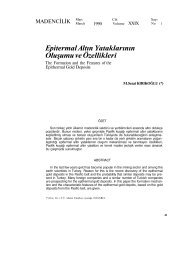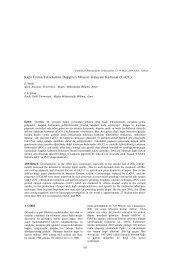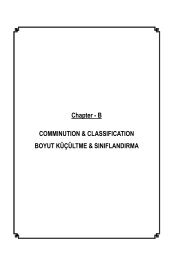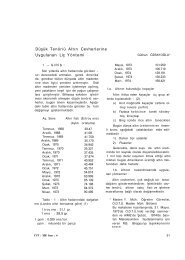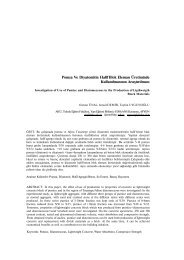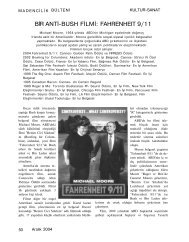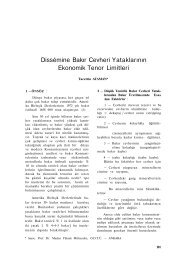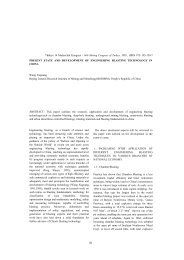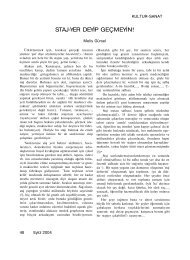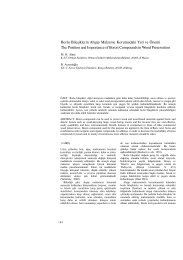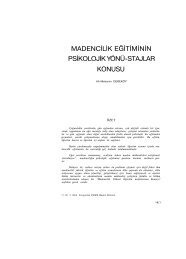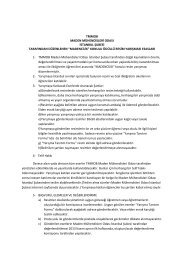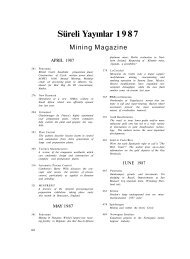A OPEN PIT MINING AÇIK OCAK MADENCİLİĞİ
A OPEN PIT MINING AÇIK OCAK MADENCİLİĞİ
A OPEN PIT MINING AÇIK OCAK MADENCİLİĞİ
You also want an ePaper? Increase the reach of your titles
YUMPU automatically turns print PDFs into web optimized ePapers that Google loves.
23 rd <br />
Surface Mining Statistics in Romania<br />
M. Marinescu<br />
Faculty of Geology and Geophysics, University of Bucharest, Romania<br />
ABSTRACT In Romania, in time but the most in XX century, were exploited 82 mineral and<br />
power substances, in over 3,478 of identified quarries and open pits. 98.5 % (3427 quarries<br />
and open pits) from the total surface exploitations extracted non-power mineral substances<br />
and 1.5 % (51) power substances.<br />
Very much exploited (78) were non-power substances (or mining commodities). Some from<br />
these (bauxite, iron ore, manganese ore, copper ore, gold-silver ore, and complex ore) were<br />
metallic ores. But the most non-power substances (73) were non-metallic mineral substances.<br />
Only 4 were power substances: lignite, coal pit, bituminous schist, and bituminous sand. The<br />
quarries and open pits were identified in all 41 counties from Romania and in Bucharest. The<br />
distribution of quarry in these counties is non-homogenous, in correspondence with the<br />
different geological structure and economical development.<br />
Key words: mining statistics, surface mining, Romanian mining statistics, Romanian<br />
surface mining, Romanian quarries<br />
1 INTRODUCTION<br />
Romanian territory is investigated in detail<br />
from geological point of view and is well<br />
known. While Romania is not a big country,<br />
because of the very complex geological<br />
structure, it has, identified and quantified in<br />
resources and reserves, 110 mineral and<br />
power substances (Marinescu, 2003).<br />
Usually, being at the ground surface or<br />
near (at little depth), the most numerous (82)<br />
from these mineral and power substances<br />
was exploited at the ground surface. The<br />
information about the surface mining comes<br />
continuous, yet from very old times.<br />
In this paper it is analyzed the surface<br />
mining situation on the bases of the present<br />
knowledge data about all times. It is evident<br />
that, about old and very old times, many data<br />
are now too slightly and this first<br />
presentation must to be improved, especially<br />
with new archaeological data.<br />
Of course, the most development of the<br />
surface mining is registered in modern times.<br />
2 SURFACES <strong>MINING</strong> ON HISTORIAN<br />
EPOCHS<br />
The surface exploitation was beginning<br />
timid from the Pre-historical times, it was<br />
strong pursued in Antiquity, it manifested a<br />
more little development in Middle Ages and<br />
had presented bigger extending to ours<br />
times. The identified quarries and open pits<br />
were upwards of 91 and the number of<br />
mineral substances had exceeded 16.<br />
2.1 Mining Surface in the Primitive<br />
Commune<br />
The slightly archaeological data about this<br />
Pre-historical time speak about some mineral<br />
substances surface exploitations: 6.<br />
Certainly, surface mining (in primitive<br />
manner) was practiced in more numerous,<br />
but unknown today sites. The firestone was<br />
much exploited but the archaeologists<br />
indicate sure exploitations at Bercea Mare,<br />
Lesnic and Roscani. In Cernat Hill, near<br />
Roscani village, together with firestone, was<br />
exploited the quartzite [Boroneant, 2000].<br />
195



